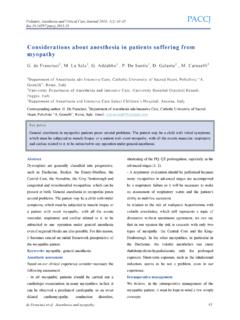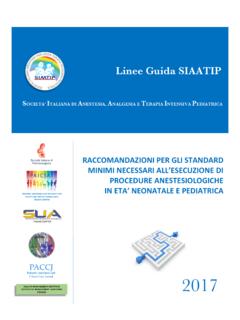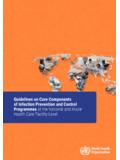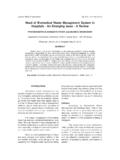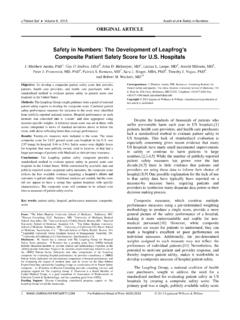Transcription of Complications of central venous catheter cannulation in ...
1 Pediatric Anesthesia and Critical Care journal 2013; 1(2):87-92 Jha et al. Complications of central venous catheter cannulation 87 Key points Various Complications can arise during the management of central venous catheter in adult and pediatric study of incidence of Complications allows us for better evaluation and to minimize the risk associated with central venous catheter cannulations. Complications of central venous catheter cannulation in tertiary care hospital ICU, a 2 years retrospective, observational study 1M. Jha, 1 Sunil Kumar. V, 1S. Bokil, 2D. Galante 1 Department of Anaesthesiology, Padmashree Dr.
2 Vitthalrao Vikhe Patil Medical College Ahmednagar, Maharashtra, India 2 University Department of Anaesthesia and Intensive Care, Paediatric Anaesthesia, University Hospital Ospedali Riuniti of Foggia, Italy Corresponding author: M. Jha, Department of Anaesthesiology, Padmashree Dr Vitthalrao Vikhe Patil Medical College Ahmednagar, Maharashtra, India. Email: Abstract Background. central venous catheter (CVC) cannulations are associated with Complications like arterial puncture, hematoma, pneumothorax, thrombosis and sepsis. These Complications may be particularly dangerous in paediatric patients. Aim. To study the incidence of Complications like arterial puncture, hematoma, pneumothorax, thrombosis and sepsis of CVC cannulations from three different routes, internal jugular vein (IJV), subclavian vein (SV) and femoral vein (FV) in critically ill patients were studied.
3 Setting & Design Medical and surgical intensive care unit of a tertiary care hospital. A 2 years retrospective, observational study. Materials and Methods This was a retrospective review of 542 CVC cannulations done on adult and paediatric patients admitted in ICU including pre and postoperative patients over 2 years period from July 2011 to June 2013. Results. Total of 542 CVC cannulations were studied, out of which 48 patients had arterial punctures, 17 had haematomas, 7 had pneumothorax, 13 developed thrombosis and 23 Sepsis. Incidence of arterial punctures ( ), hematoma ( ) and pneumothorax ( ) were more with SV cannulations.
4 Sepsis ( ) and thrombosis ( ) were more with FV cannulations. Conclusions. Internal jugular venous access is associated with low rate of severe Complications as compared with subclavian and femoral vein access. Keywords: central venous catheter cannulation ; Complications ; intensive care unit. Introduction central venous catheters (CVC) are an integral part of patients care in the intensive care unit (ICU). The indications for CVC are monitoring of the haemodynamic state of the patient, pulmonary artery catheterization, emergency transvenous pacemaker, hemodialysis, severe hypovolaemia with difficult Pediatric Anesthesia and Critical Care journal 2013; 1(2):87-92 Jha et al.
5 Complications of central venous catheter cannulation 88 peripheral venous access, total parenteral nutrition and irritant medications. However, Complications associated with CVC occur in nearly 15% of patients, mainly mechanical Complications (5 19%), infectious Complications (5 26%) and thrombotic Complications (2 26%).[1,5] These Complications results in prolong stay in ICU and increases the cost of treatment, increase in morbidity and mortality.[2] Despite the advent of ultrasound-guided vascular cannulation , which has reduced the incidence of Complications drastically, many hospitals in India andother developing countries still rely on the landmark based technique for cannulation , which has a reported success rate of 75 99%.
6 [3] However, there are very little data available from Indian ICUs on therate of Complications associated with CVC. Hence, we undertook a retrospective study to find out the incidence of Complications like arterial punctures, hematoma, pneumothorax, thrombosis and sepsis of CVC inserted by the landmark based technique in adult and paediatric patients in ICUs. Material and Methods After approval from the hospital ethical committee, we retrospectively analyzed all landmark-based CVC cannulations using Seldinger technique performed during July 2011 to June 2013 in 542 patients in our hospital. CVC cannulations from three different routes IJV, SV and femoral vein in critically ill patients were analyzed.
7 We recorded baseline data for each patient and APACHE II score were noted. CVC were inserted either by an ICU consultant or by a senior registrar, who had minimum experience of at least 25 CVC insertions, under supervision. Puncture site was chosen according to clinical status of the patient. CVC in operation theater, casualty and by inexperienced residents were excluded from study. Data, such as indication, Complications and site of CVC cannulation were recorded. During cannulation if red bright colored blood gushed into the syringe, arterial puncture was suspected. Needle was withdrawn from the insertion site, pressure was applied for 5 minutes and the site was abandoned for cannulation .
8 If patient developed unexplained tachypnea and/or tachycardia during cannulation , procedure was abandoned and chest radiograph was taken to check for pneumothorax. If patient had symptoms of catheter related blood stream infection (CRBSI) and/or local infection blood culture/ site swab was sent for culture and sensitivity. In paediatric patients the procedure was always performed under sedation. catheter -associated infections were defined as follows [4]: (1) exit site infection erythema, tenderness, induration, purulent discharge and growth on culture. (2) catheter tip colonization growth on culture of the distal segment ofthe CVC with clinical signs of infection.
9 (3) CRBSI isolation of the same organism from the catheter tip culture and from at least one of the two blood cultures, along with signs and symptoms of infection. Thus, patients with clinical signs of infection and in whom the CVC tip showed a positive growth without associated bacteremia was considered as catheter tip infections. Whereas patients with clinical evidence of infection along with positive growth of the same organism on blood culture as well as CVC tip positive culture were diagnosed to have CRBSI. Results A total number of 542 CVC (15% = 81 CVC in paediatric patients) were inserted using Seldinger technique.
10 The incidence of arterial punctures occurred more common with SV cannulation in , followed by femoral vein and IJV cannulations % (figure 1). The incidence of haematomas was with SV, when compared to with IJV and femoral vein cannulations. However, hematomas subsided without any intervention. had pneumothorax with SV, when compared with with IJV cannulations. developed sepsis with femoral vein, when compared to 5% with SV and with IJV cannulations. Pediatric Anesthesia and Critical Care journal 2013; 1(2):87-92 Jha et al. Complications of central venous catheter cannulation 89 Figure 1.


